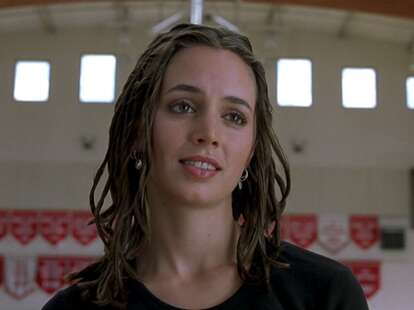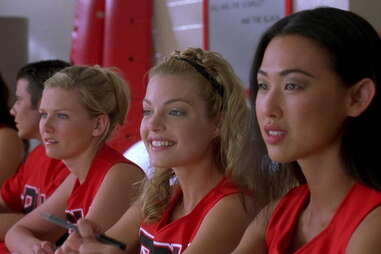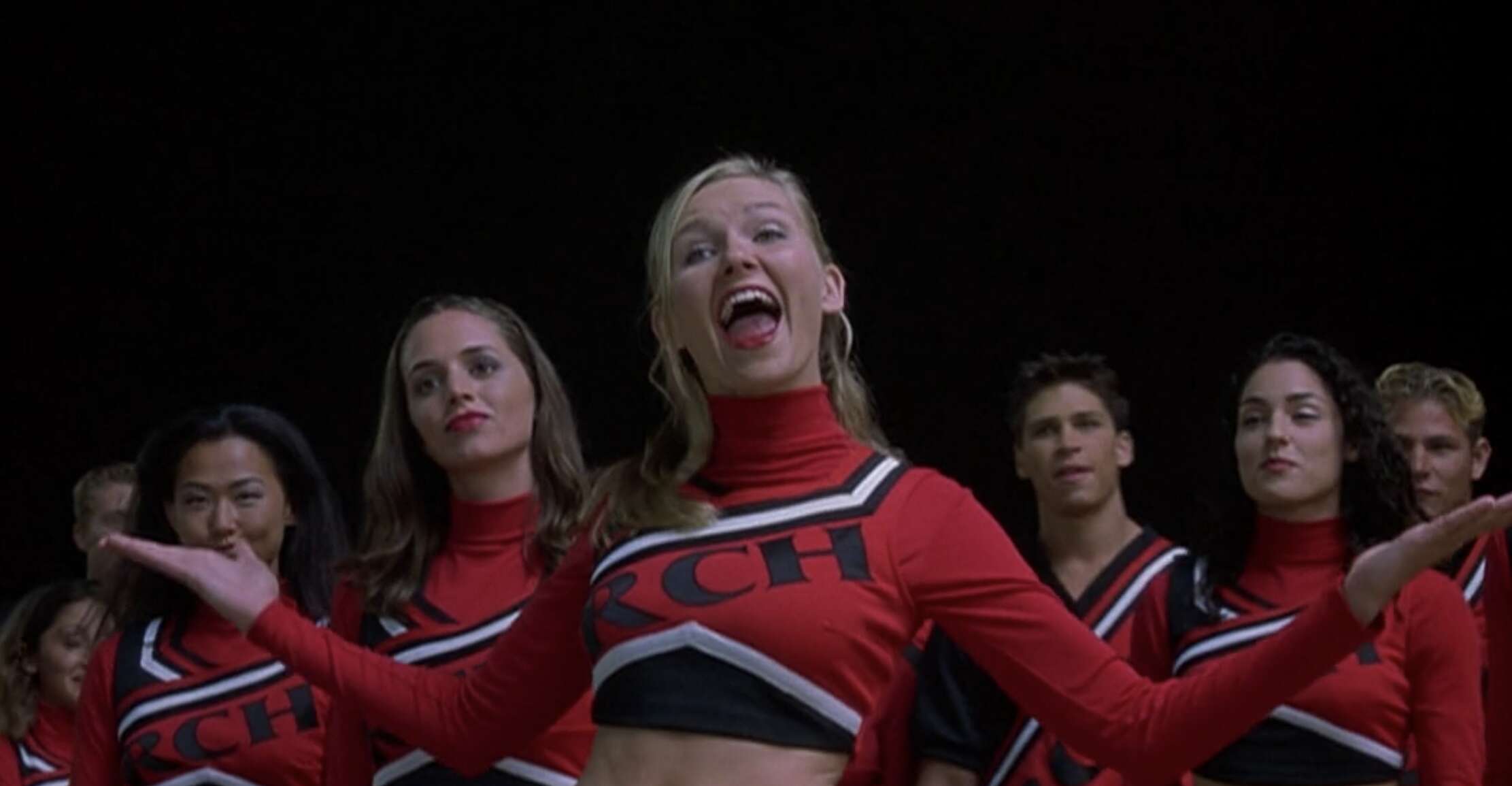How the Iconic Audition Scene in 'Bring It On' Came to Life
Revisiting the teen movie's best moment, 20 years later.

Bring It On is a movie packed with iconic entrances. The audience first meets Kirsten Dunst's bubbly cheer captain Torrance Shipman in one of her nightmares. The way Gabrielle Union's Isis, from the rival East Compton Clovers, struts onto screen is awe-inspiring. Even the ridiculous choreographer Ian Roberts' Sparky Polastri gets a dramatic introduction, with director Peyton Reed's camera first highlighting his Bob Fosse-esque boots, before panning upward.
But perhaps no entrance is more iconic than that of Eliza Dushku's Missy, who swaggers into auditions for the Rancho Carne Toros squad in cargo pants and a crop top looking like a version of Gwen Stefani who is ready to fuck shit up. When I was given the opportunity to get on the phone with Reed and writer Jessica Bendinger to celebrate the movie's 20th anniversary, my main objective was to break down that moment and all things Missy. Of course, I slid some other burning questions in there.
Missy evolved out of Bendinger's own experience with cheer
Bendinger was a childhood gymnast who eventually literally grew out of the sport, getting too tall. When she first came across a cheer competition on ESPN, she felt a rush watching the high flying stunts. "Bring It On is born out of the magma of my failed gymnastics career," she says. Missy is the most direct representation of that: Someone extremely talented who is defensive of that talent. "If you're a cool kid, [cheerleading] has a little bit of a goody two shoes reputation," she says. Even when Bendinger was first watching cheer competitions she encountered that reaction from befuddled friends. Missy, who is a transfer from LA, is the antithesis of this. She has her keys on a chain and has drawn a tattoo on herself. When asked to perform a cheer, Missy responds: "I transferred from Los Angeles, your school has no gymnastics team, this is a last resort."
The tumbling is a trick of the trade
Missy proves herself by executing a "front handspring, step out, round off back handspring, step out, round off back handspring, full twisted layout." But obviously that's not Dushku. Reed, at first, asked a choreographer whether the actress could learn the move in time for shooting, when that was (obviously) not a possibility he opted for a "Texas switch em up," having a stunt person execute the flips and then swapping in the actress at the last possible moment. The trickiest bit was finding a gymnast who looked enough like Dushku to pull the thing off.

The Toros dialogue was inspired by drag queens
Bendinger did her research, lurking on cheer message boards in the "dial up days," but she also wanted the movie to have a sort of timelessness: Enter drag queens. Coached by her mentor Daniel Waters, writer of Heathers, to make sure the movie wouldn't be stuck in 2000, Bendinger started playing around with the Toros' dialogue. "I got this notion that I wanted the cheerleaders to be kind of drag queens," she says. "If you watch RuPaul's Drag Race you know how hilariously deadly drag queens can be. I called a drag queen in San Francisco and I said, 'Give me all the funny lines.' And they did. I remember that conversation." During the audition sequence, Torrance asserts her authority by declaring: "Courtney, his is not a democracy, it's a cheerocracy." This prompts Courtney (Clare Kramer), to call her a "cheertator." "I really got into breaking words apart and putting them together," Bendinger remembers.
Missy has punk in her DNA
Bendinger had a very specific look in mind for Missy. She wrote in her character description that it "looks like she's a roadie for Social Distortion," a SoCal punk band. There's also a little of Gwen Stefani thrown in there. "I was so into that ska, Orange County music culture or appropriating tough-looking gear," Bendinger adds.
Courtney's homophobia was intended to be a realistic depiction of high school
Courtney also dishes out some nasty homophobia in her efforts to alienate Missy, calling her a "dyke." The wannabe queen bee, Courtney is threatened by the appearance of this talented outsider. "When teenagers are threatened, it's not pretty," Bendinger says. The way she lashes out is part of Bendinger and Reed's effort to represent an accurate, if heightened high school experience. It also might be one of the main elements of the movie that seem dated. "I definitely wanted to highlight that ridiculous homophobia that existed at that time back then," Bendinger says. "The slurs are ridiculous." Reed recognized that growing up in the '80s in the South. "It was something that we thought about," Reed says. "We're going to great a context for these cheerleaders who are the protagonists of this thing, part of it is this hate speech that you're surrounded by as a high school student. We didn't really want to shy away from that."

They wanted more from the auditions
Before Missy enters the gym, the Toros suffer through a series of embarrassing auditions, including a ballet dancer, a rapper, and a girl who thinks she's in a Whitesnake video. Reed wanted even more. A theater kid sings "Give My Regards to Broadway," which in the script was "Corner of the Sky" from the musical Pippin -- the ultimate audition song -- but Reed couldn't get the music rights. "When you do one of those montage things, you're like, well, let's shoot three times what we'll need in the final edit and there was no money," Reed remembers.
Missy is a Sleater-Kinney fan, and also a privileged latchkey kid
One thing you notice on your five millionth rewatch of Bring It On are the posters that adorn the bedroom walls of the likes of Torrance, Missy, and her brother Cliff (Jesse Bradford). Torrance has an image of Nancy Kerrigan above her bed, which makes total sense. Of course, a driven goody two shoes like Torrance would idolize the figure skater. Cliff's got tons of band posters, including selections from Merge Records, for whom Reed made videos. And Missy's got Sleater-Kinney, the riot grrrl band featuring Carrie Brownstein and Corin Tucker. "Missy and Cliff are kind of like these privileged latchkey kids," Reed explains. "Their parents are never around and they are in this big mansion and then they have their little corners in their rooms."
The notion that Missy and Cliff are alternative but also rich feeds into the stratified world that Reed and Bendinger created, which feeds the main conflict of the movie. Even though Missy arrives and ushers Torrance out of her naiveté, Missy is just a jaded version of the same person. "The whole movie is Kirsten's character realizing a little bit this bubble that she lives in and her complicity in institutionalized racism," Reed says. Watching Bring It On now you're struck by how it's a pretty spot on portrayal of white guilt. Missy's outsider status means she can identify that the Toros have stolen all of their cheers from the Clovers, but she also comes from a rarefied world. It's just a slightly more awesome one than Rancho Carne. She just needs to succumb to her "last resort" to kick off the entire plot of the movie.
Need help finding something to watch? Sign up here for our weekly Streamail newsletter to get streaming recommendations delivered straight to your inbox.
